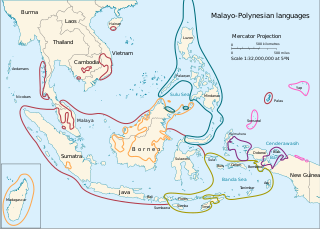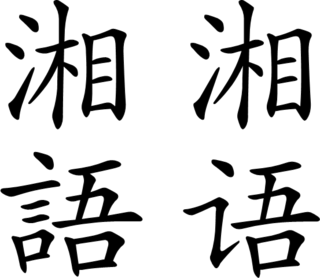
In group theory, a branch of mathematics, given a group G under a binary operation ∗, a subset H of G is called a subgroup of G if H also forms a group under the operation ∗. More precisely, H is a subgroup of G if the restriction of ∗ to H × H is a group operation on H. This is usually denoted H ≤ G, read as "H is a subgroup of G".

The Malayo-Polynesian languages are a subgroup of the Austronesian languages, with approximately 385.5 million speakers. The Malayo-Polynesian languages are spoken by the Austronesian people of the island nations of Southeast Asia and the Pacific Ocean, with a smaller number in continental Asia, going well into the Malay peninsula. Cambodia and Vietnam serve as the northwest geographic outlier. On the northernmost geographical outlier does not pass beyond the north of Pattani, which is located in southern Thailand. Malagasy is spoken in the island of Madagascar located off the eastern coast of Africa in the Indian Ocean. Part of the language family shows a strong influence of Sanskrit and particularly Arabic as the Western part of the region has been a stronghold of Hinduism, Buddhism, and, since the 10th century, Islam.

Athabaskan or Athabascan is a large family of indigenous languages of North America, located in western North America in three groups of contiguous languages: Northern, Pacific Coast and Southern. Kari and Potter 2010:10 place the total territory of the 53 Athabaskan languages at 1,563,000 mi2 or 4,022,000 km2.

Minangkabau is an Austronesian language spoken by the Minangkabau of West Sumatra, the western part of Riau, South Aceh Regency, the northern part of Bengkulu and Jambi, also in several cities throughout Indonesia by migrated Minangkabau. The language is also a lingua franca along the western coastal region of the province of North Sumatra, and is even used in parts of Aceh, where the language is called Aneuk Jamee. It is also spoken in some parts of Malaysia, especially Negeri Sembilan.

The Zhuang languages are any of more than a dozen Tai languages spoken by the Zhuang people of southern China in the province of Guangxi and adjacent parts of Yunnan and Guangdong. The Zhuang languages do not form a monophyletic linguistic unit, as northern and southern Zhuang languages are more closely related to other Tai languages than to each other. Northern Zhuang languages form a dialect continuum with Northern Tai varieties across the provincial border in Guizhou, which are designated as Bouyei, whereas Southern Zhuang languages form another dialect continuum with Central Tai varieties such as Nung, Tay and Caolan in Vietnam.
Standard Zhuang is based on the northern Zhuang dialect of Wuming.

The Kanuri people are an African ethnic group living largely in the lands of the former Kanem and Bornu Empires in Niger, Nigeria and Cameroon. Those generally termed Kanuri include several subgroups and dialect groups, some of whom feel themselves distinct from the Kanuri. Most trace their origins to ruling lineages of the medieval Kanem-Bornu Empire, its client states or provinces. In contrast to neighboring Toubou or Zaghawa pastoralists, Kanuri groups have traditionally been sedentary, engaging in farming, fishing the Chad Basin, and engaged in trade and salt processing.
The Wari', also known as the Pakaa Nova, are an indigenous people of Brazil, living in seven villages in the Amazon rainforest in the state of Rondônia. Their first contact with European settlers was on the shores of the Pakaa Nova River, a tributary of the Mamoré River. Many of them live within the Sagarana Indigenous Territory.

Crimean Tatar, also called Crimean Turkic or simply Crimean, is a Kipchak Turkic language spoken in Crimea and the Crimean Tatar diasporas of Uzbekistan, Turkey, Romania and Bulgaria, as well as small communities in the United States and Canada. It should not be confused with Tatar proper, spoken in Tatarstan and adjacent regions in Russia; the languages are related, but belong to two different subgroups of the Kipchak languages and thus are not mutually intelligible. Crimean Tatar arrived in the 13th century with the Mongol Golden Horde, succeeding the Crimean Greek and Crimean Gothic Principality of Theodoro, and continued through the 15th–18th century Crimean Khanate period. Though only distantly related, it has been extensively influenced by nearby Oghuz Turkic languages such as Turkish, Turkmen and Azerbaijani.
The Western Nilotic languages are one of the three primary branches of the Nilotic languages, along with the Eastern Nilotic languages and Southern Nilotic languages; Themselves belonging to the Eastern Sudanic subfamily of Nilo-Saharan. The about 22 Western Nilotic languages are spoken in an area ranging from southwestern Ethiopia and South Sudan via northeastern Democratic Republic of the Congo and northern Uganda to southwestern Kenya.

Xiang or Hsiang, also known as Hunanese, is a group of linguistically similar and historically related varieties of Chinese, spoken mainly in Hunan province but also in northern Guangxi and parts of neighboring Guizhou and Hubei provinces. Scholars divided Xiang into five subgroups, Chang-Yi, Lou-Shao, Hengzhou, Chen-Xu and Yong-Quan. Among those, Lou-shao, also known as Old Xiang, still exhibits the three-way distinction of Middle Chinese obstruents, preserving the voiced stops, fricatives, and affricates. Xiang has also been heavily influenced by Mandarin, which adjoins three of the four sides of the Xiang speaking territory, and Gan in Jiangxi Province, from where a large population immigrated to Hunan during the Ming Dynasty.

The Eastern Algonquian languages constitute a subgroup of the Algonquian languages. Prior to European contact, Eastern Algonquian consisted of at least 17 languages, collectively occupying the Atlantic coast of North America and adjacent inland areas from what are now the Maritimes of Canada to North Carolina. The available information about individual languages varies widely. Some are known only from one or two documents containing words and phrases collected by missionaries, explorers or settlers, and some documents contain fragmentary evidence about more than one language or dialect. Nearly all of the Eastern Algonquian languages are extinct. Miꞌkmaq and Malecite-Passamaquoddy have appreciable numbers of speakers, but Western Abenaki and Delaware are each reported to have fewer than 10 speakers after 2000.
In historical linguistics, a linkage is a group of related languages that is formed when a proto-language breaks up into a network of dialects that gradually differentiates into separate languages.
The Central Algonquian languages are commonly grouped together as a subgroup of the larger Algonquian family, itself a member of the Algic family. Though the grouping is often encountered in the literature, it is an areal grouping, not a genetic grouping. In other words, the languages are grouped together because they were spoken near one another, not because they are more closely related to one another than to other Algonquian languages. Within the Algonquian family, only Eastern Algonquian is a valid genealogical group.
The Northwest Sumatran languages are a group of languages spoken by the Batak and related peoples in the interior of North Sumatra and by the Nias, Mentawai people, and others on the Barrier islands off the western coast of Sumatra.
The Sumba–Flores languages, which correspond to the traditional Bima–Sumba subgroup minus Bima, are a proposed group of Austronesian languages spoken on and around the islands of Sumba and western–central Flores in the Lesser Sundas. The main languages are Manggarai, which has half a million speakers on the western third of Flores, and Kambera, with a quarter million speakers on the eastern half of Sumba Island.
The Timoric, or sometimes Timor–Babar, languages are a group of fifty Austronesian languages spoken on the islands of Timor, neighboring Wetar, and the Babar Islands to the east.

Ji–Xu Xiang (吉漵片), also known as Chen–Xu (辰溆片), is a cluster of Xiang dialects spoken in western Hunan that do not fit into the traditional New Xiang–Old Xiang dichotomy. They are geographically separated from the New Xiang dialects that they were traditionally grouped with.
Naruo 纳若 is a Loloish language cluster spoken by the Yi people of Yunnan, China.
In Chinese dialectology, Beijing Mandarin refers to a major branch of Mandarin Chinese, encompassing a number of dialects spoken in areas of Beijing, Hebei, Inner Mongolia, Liaoning and Tianjin, the most important of which is the Beijing dialect, which provides the phonological basis for Standard Chinese.












